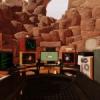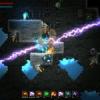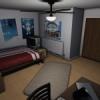Shortly before Christmas I was given the opportunity to interview Brjánn Sigurgeirsson: the CEO of Image & Form, the small Swedish development studio that delighted gamers around the world when they released Steamworld Dig on the 3DS in August 2013 (I reviewed the Steam port of the game just recently).
We’ve already published the first part of that interview just before Christmas, where Brjánn gave us exclusive info on their next game. Now we present the second part of our chat. Read on for Brjánn’s thoughts about indie game development, the games industry as a whole and the pressure of success.
To start with, I ask Brjánn to tell me more about the team – who they are, where they come from and how they work. Games don’t just appear from the ether, after all - they take time, resources and manpower to create.
“Image & Form didn’t start yesterday. It started in 1997 actually as a multimedia presentation company, turned into a web development company, turning into a game developer along the way. For a long time between 2002 and 2009 in games development, we were making kid’s games for PC and Mac, play-and-learn games. It was fun in the beginning, but it started dragging on towards the end because we came up with our own game ideas. We really wanted to go towards our own content and doing work-for-hire is just so restrictive.
“So I hooked up with our art director who I think is probably one of the best art directors in the world: Tobias Nilsson. He’s a great guy who joined the company back in 2004. We made a few trial-and-error games on iOS in 2009-2010. Then in 2011 we made a
game called Anthill on iOS, which is actually kind of the first game that put us on the map. Apple picked it as Game of the Week before it came out, so we made some decent money from that. But prior to that in 2009, I hired our lead designer, who also has to be mentioned: Olle Håkansson, who is sort of the brain behind Steamworld Dig. He keeps everything in check. Everyone has ideas and he keeps it a lean, mean project. He’s a brilliant guy. So those guys are very influential. The way Tobias draws it is the way it needs to look; the way that Olle designs it is the way it’s supposed to play.
“The rest of us are just filler.” He laughs warmly. “No, it’s not really like that! There’re 12 of us on the payroll and we have 2 great interns as well. Everybody is just very creative. I’d say that it’s a unique team that way, because no-one is restricted. Everybody has ideas and gets a little bit of their own thoughts into every game that we make. I think Image & Form is a lovely company that way: no idea is too stupid, there’s no one person who decides what a game is going to look like in the end.”
Having already asked Brjánn about which platforms they are looking to support when they are ready to release their new title (see the previous interview), I was curious about what he thought of the different platforms available. It’s well documented that many Indie developers experienced a lot of difficulties working with Microsoft in the past. To get themselves noticed, they needed to be on the main Arcade channel, as the Indie channel was so full of dubious “massage” applications that it became difficult to get noticed; but being on Xbox Live Arcade came with its own set of difficulties, not least of which were the need for a publisher and a litany of high costs for certification. And the App Store is an increasingly crowded market, with the majority of developers never actually making a profit.
“It’s quite prohibitive, right?” Brjánn replies in agreement. “The difference between Xbox Live Arcade and Xbox Indie Games is just massive.
“We were a mobile developer from the beginning, and the decision to make Steamworld Dig for the 3DS was made because we love that machine, and the 3DS lent itself perfectly [to the game].
“But at the same time, the decision was also influenced by the fact that [Apple’s] App Store was getting so crowded; getting recognition was extremely difficult. And if you got recognized, it was for a very short period of time. So we wanted to go to a sort of Blue Ocean platform, where we could stay noticed for a few days rather than a few minutes.”
It’s a decision that certainly seems to have paid off for them – releasing Steamworld Dig on the 3DS put the developer on the map and they certainly benefited from the enthusiasm with which Nintendo themselves promoted the game.
But Steamworld Dig was also recently released on Steam, which is another crowded market. “Surely that can make it difficult to get noticed as well?” I ask.
“Steam has been very restrictive in the past, in terms of how many games they release on the platform. So when there has been a new game coming to Steam, people have known about it in advance.”
I mention to him that things are starting to change in that area, with Greenlight and Early Access.
“It is,” he acknowledges, “and many games are being Greenlit in chunks and so on. I sort of hope that Steam will keep the quality high on that platform and that Valve doesn’t try to create an alternative to the app store or Google Play, where it’s really hard to stand out and hard as a consumer to find a game that you really want. Also, as a consumer, you want to know that if you buy a game on a certain platform that it’s going to be good.
“Nintendo, Microsoft and Sony are really embracing indies right now. I think that in the grand scheme of things that’s good; the barrier to get onto their platforms is getting lower. But at the same time, I hope that they continue to moderate their content in the same way that they’ve done in the past so that quality games survive.”
With all the talk of Indie gaming, it needs to be remembered that a large chunk of the industry remains dominated by just a few larger publishers who continue to churn out major game after major game. But there appears to be a gradual homogenization of content, with so many of the so-called “AAA” games attempting to mimic the success of another by replicating what made those competitors popular. Could this slow congealing of game design be responsible for the rise of Indie Games that we’ve witnessed in the last few years? Are people finally starting to get bored of big-budget releases and endless sequels?
“I can’t agree more!” Brjánn says enthusiastically, and it’s clear that he’s passionate about this topic. “There’s so much money involved that big publishers have had a tendency recently to just stick to what they know works. Nintendo, Microsoft and Sony are wooing the Indie community right now and I think it really has to happen for the games industry to not become too stale, or for everything not to just become the same genre.”
What about Ouya? The console was built from the ground up with indie and home-brew development in mind, but it hasn’t been without its fair share of controversies – the company recently found itself in hot water with the community over some of its policies when giving funding to developers on Kickstarter.
“I think anything that comes up as an underdog in this industry is very interesting,” comes my reply. “Ouya was a breath of fresh air; the number of available platforms to make software for is sort of limited, but then they came on strong and said “this is going to be a viable platform.”
“It hasn’t all been sweetness and roses though,” I note.
“There are a few things that work against them,” he says, nodding. “When bad truths like what you mentioned before surface, then it’s not good for them. I think also that they’ve been trying to do stuff in a renegade fashion, ‘us against the big dogs’.” He laughs as he remembers: “When they were having their show at E3, they did it out in the parking lot. Then all of a sudden there was just this huge bus in front of what they were trying to show on their screen!”
“But I think you should always root for people that try to do something new, something radical; [We need] people who dare to think big, and think original. We just don’t have that right now, and without it we’re definitely going to [end up] where we don’t dare to go to outside of certain areas.”
However, he does qualify his answer. “I haven’t been following Ouya so closely in the last couple of months; the last impression I had was that the content coming for it wasn’t that strong. They focused very much on just a couple of major successes and even among those, although they’ve been successful, the quality or the content hasn’t been there to sustain them.”
Why does he think that is?
“Maybe it’s the breadth of their portfolio. They went and almost promised too much by saying ‘we will have X amount of brilliant games on this platform by such-and-such a date’, but they just couldn’t deliver on it. That’s the worst thing anyone can do – go out and say something and then later hope that no-one’s going to remember that you actually said those things.”
But they do remember. Gamers – particularly “core” gamers, have long memories. Continuing his answer, Brjánn suddenly shows a glimmer of what could perhaps be frustration and I have to wonder where it comes from, what personal anecdote is crossing his thoughts.
“But especially games journalists, they tend to remember,” he sighs. “And they’re not slow to rake up the past. You want to say, ‘But look at it! That’s not what it looks like anymore!
“So it can sometimes feel like you’ve failed to deliver on your promises to both players and the press. And with failure, everybody says it drives you forward but that’s only true to a certain extent.”
Our discussion is moving into an area that I want to explore further with him – the pressure to succeed. After having spent some of our time discussing the developer’s next project, I wondered if Brjánn was feeling the pressure to produce a follow-up which lives up to people’s expectations. After all, with so many awards and with so much critical acclaim now under its belt, many will be expecting bigger and better things from the studio, and in the minds of many, a developer is only as good as their last game.
Unsurprisingly, it’s a subject that he’s put a lot of thought into; but when he answers, he does so lightheartedly and with the same easy-to-like smile with which he answered my previous questions.
“[This] sort of brings me back to Steamworld, because the game that we’d started developing, the prequel to Dig… I played that game, or at least a vertical slice of it, but when we finished porting Dig to Steam, we discussed it and we sort of came to the conclusion that it was great, but not grand enough. We’d made Dig and we have these expectations of ourselves that the next game we make has to be a positive surprise in every single aspect of it.
“It’s like, you release your Debut Album and everyone’s sort of asking you the whole time when the next album is coming out, so it just gets rushed. Then you put it out there but it’s just more of the same and people say it’s not good enough. They’ll say, ‘yeah
it’s good, but we thought this b*stard was going to come up with something original but no, it’s just the same old tired stuff’. As a creator you just sort of sit there and you’re like, ‘what the f*ck? This is exactly what you were asking me to do!”
We both share a laugh and I mention the band Radiohead, how they got so sick of people asking them how they were going to follow OK Computer that eventually they decided to confound everyone’s expectations by releasing Kid A.
Brjánn laughs again. “Exactly! I don’t even particularly like Kid A - If I was stranded on a deserted island I’d rather have OK Computer with me - but yeah, it was really brave! I think they should be commended for that.”
Thinking about what he’d mentioned about the pressure to deliver, I ask if there were any features that never made it into Steamworld Dig that had originally been planned. Was anything removed, either due to time constraints or design decisions?
“That’s a very good question. In the beginning, we sort of had the idea that we wanted people to dig intelligently, so that you always had to have a path up. In the beginning we didn’t have the wall jump and were very afraid that if people just dug one long vertical shaft they would finish the game in about the same amount of time that you can finish the game in today; we kept telling ourselves ‘it’s going to be a problem, it’s going to be too short.’
“But then we realized that it would just become boring if you always had to think about being able to only jump one step up. So instead we decided “this isn’t fun enough, let’s add in a wall jump and see if that works. Then we can think about how we can extend the length of the game in other ways.”
I ask if that was when they made the decision to bring in different densities of rock that can’t immediately be excavated, and the need to dig around things.
“Yeah, he replies. “And also more caves: In the beginning we had some caves that people could visit and solve platforming puzzles. But it became more of a core feature when we decided that we needed to give people more freedom to dig how they wanted.
“But all of this meant that for a good while during development, we’d been going in the wrong direction; we had to backtrack and redesign the game. That meant that some elements we’d originally planned for it didn’t make it in. In Steamworld Dig there are different layers [of the world] underneath each other. In the beginning we’d planned six layers like that. [But] it’s not just that we had to cut that content, it’s also that we had to make it a lean game. If we had made it longer I think people would have thought there was a lot of filler and wonder ‘how many more hundred feet do I need to dig before getting my next upgrade?’”
I note that it’s a very tight game, about the right length to leave people wanting more without the chance to get bored with the gameplay.
“When we were done with it, I think the length of the game was perfect. What I would have wished for is that we’d had maybe one more month in development to add bosses to each area for example. Maybe a few more enemies would have been nice. But to make the game we borrowed a mountain of cash and when we were doing the books we realized that we just couldn’t afford to borrow any more money; we’d have been so far down in a hole that we wouldn’t have been able to climb out of it. And if it had tanked, we’d just have had to leave the offices in the middle of the night without telling the landlord!”
I ask him what the original inspiration behind the game was. A lot of people have compared it to Spelunky, for example.
“I think that when we released on Steam we were very sloppy with the description text; I can’t remember exactly how we worded it, but we originally said something like “this game is inspired by Metroidvania games and Terraria.
“It’s very rude of us actually to be that sloppy. We don’t think that Steamworld Dig is anything like Terraria and we’re not just trying to ride on its success, it’s just that it’s a 2D mining game seen from the same perspective and so that’s the only thing that we wanted to convey. It doesn’t play anything like Terraria but if you can sort of get people the mind-set of “ok, this is how it looks and you destruct the environment in 2D” then people will get the right idea of what they could expect, graphics-wise.
“Other people have compared it to Spelunky and I think that, gameplay-wise, it’s nothing like those games. They all just happen to be 2D games that take place underground in mines. Gameplay-wise, Spelunky is not very similar; it’s a roguelike. Our game is more like Metroidvania-meets-Dig Dug-meets-Miner Dig Deep and Motherload.
“I’d rather people not say that it’s a rip-off of Motherload. Yeah it’s another mining game, Terraria is another mining game. I think that mining itself intrigues us. It’s a lovely thing, where you dig down into the earth hoping to find something.”
Is that what he thinks defines his game then?
“In Steamworld Dig you find these gems and stuff but you don’t know what it is that you’re going to find until the very moment that you’ve actually dug it up. It’s a beauty in itself; it’s a wonderful thing to find and discover things. So we wanted to make a game like that and we were so impressed by classic games like Super Metroid that we really wanted to have elements like that in there, because it’s a brilliant way of pacing a game.”
I leave Brjánn and the rest of the team to carry on with their work as they’ve got plenty to be getting on with before breaking for Christmas – in Sweden, he tells me, their Christmas celebrations start earlier than ours – and I’m conscious of not wanting to take up any more of their time.
It’s clear that Brjánn has thought long and hard about the Industry, Indie development and also what the success of Steamworld Dig means for their future. There’s a certain weight of responsibility on the studio’s shoulders that they feel all too keenly, but it doesn’t seem to be a weight that they carry as a burden; rather, it appears to be a motivation for them to move forward and continue to deliver new and exciting games which explore new ideas.
For all of the success and recognition that Image & Form have managed to achieve in just a short space of time, it’s very clear that their journey is only just beginning. I can’t help but wonder where that voyage takes them in the future.








